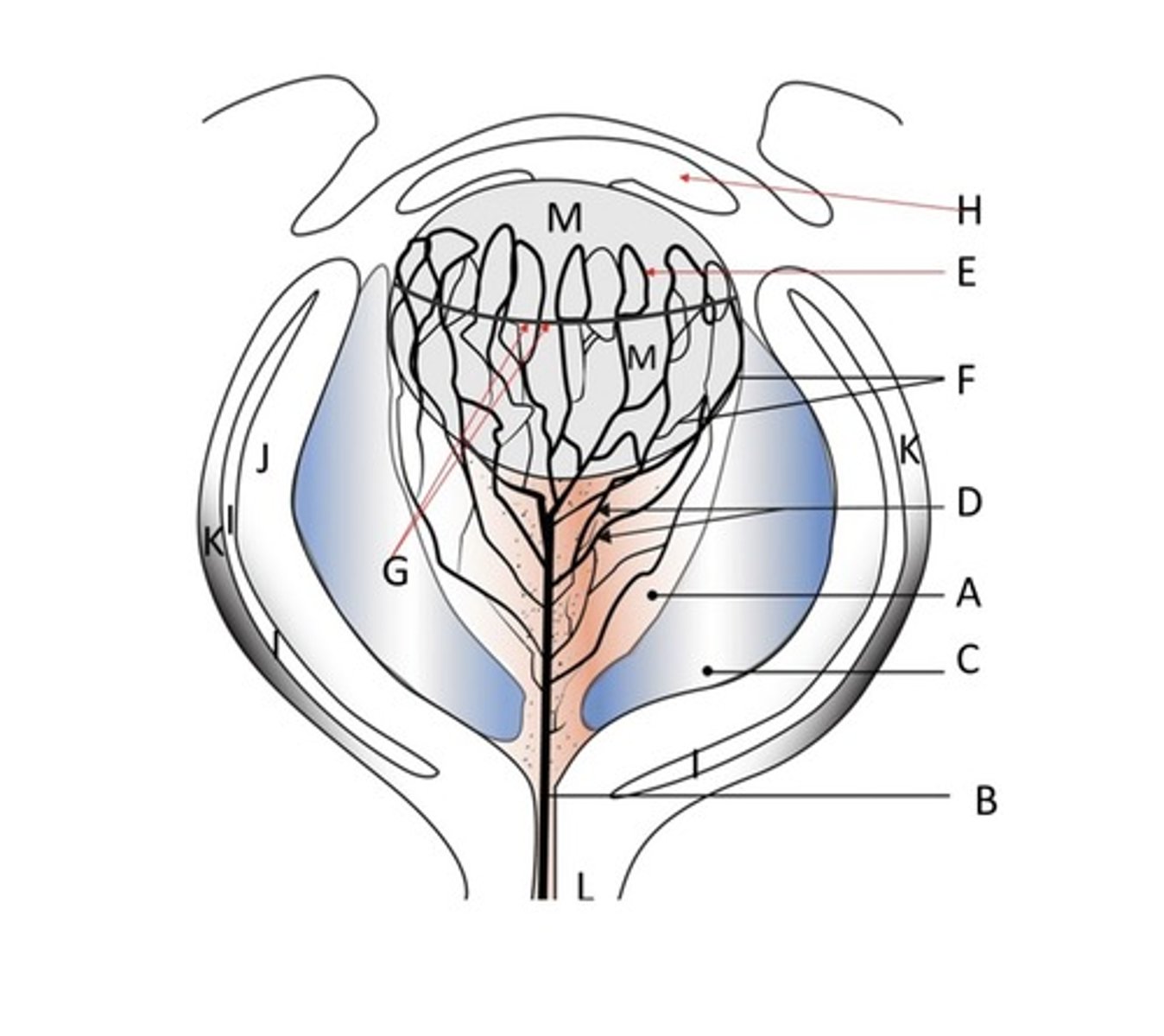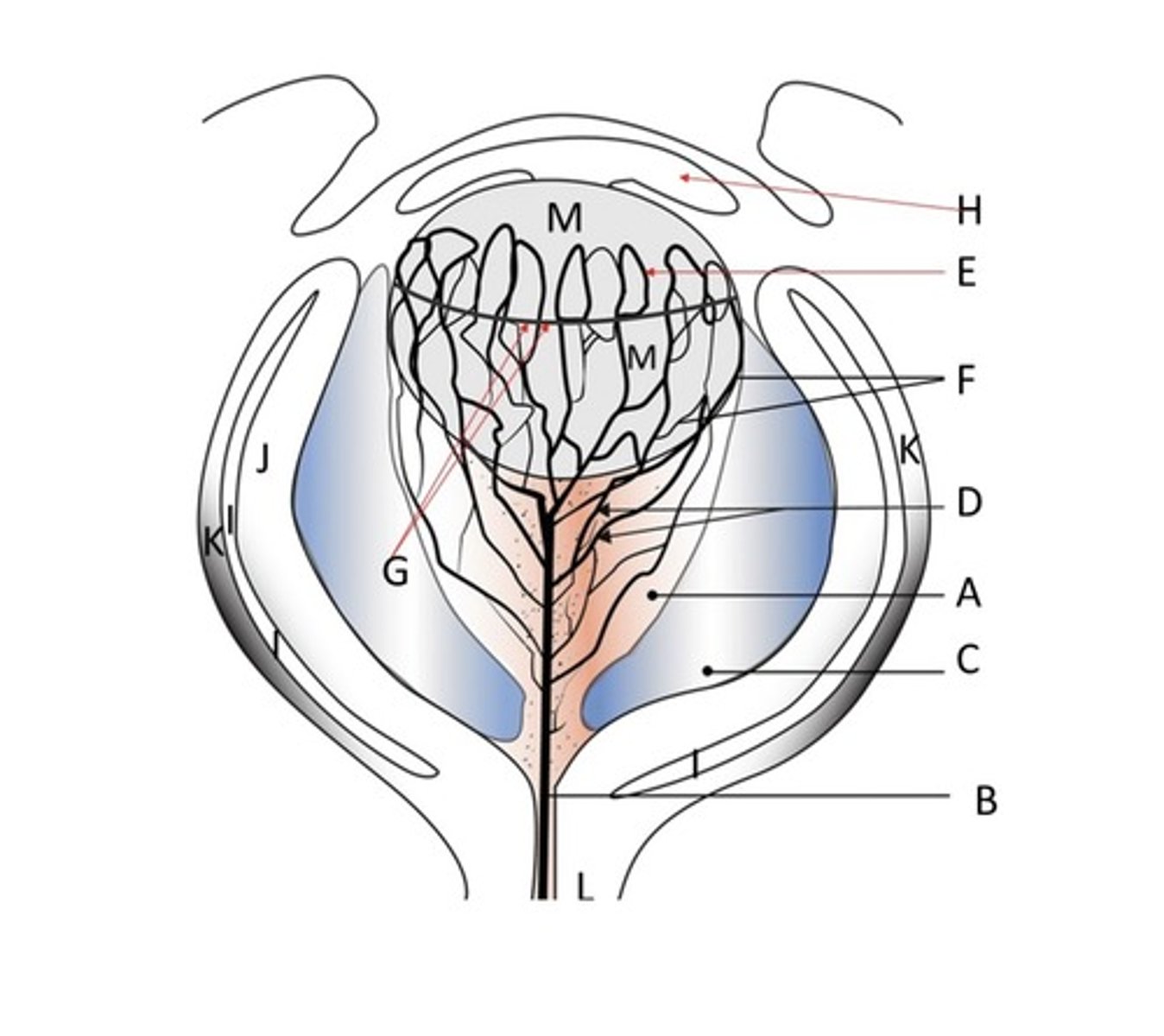Crystalline Lens Physiology
1/74
There's no tags or description
Looks like no tags are added yet.
Name | Mastery | Learn | Test | Matching | Spaced |
|---|
No study sessions yet.
75 Terms
What two properties of the lens allow for clear, sharp vision?
transparency and gradient of refractive index
What are the 5 keys to lens transparency?
1) absence of blood vessels
2) few cellular organelles
3) orderly arranged lens fibers
4) barrier to extracellular diffusion
5) matching refractive index of the membranes and cytoplasm of fiber cells in the lens nucleus
Although the lens in avascular, it has blood vessels during development. What is the vasculature that supplies the posterior lens?
the hyaloid artery provides the tunica vasculosa lentis, which is the capillary network that engulfs the posterior lens

What is the vasculature that supplies the anterior lens during development?
anterior lens is surrounded by the anterior pupillary membrane which originates from the iris anterior stroma as well

When does vascularization of the lens regress during development?
during second trimester
What happens to the organelles once lens fiber cells elongate?
lens fiber cells lose their organelles rapidly, including mitochondria, nuclei, and ER
Why is losing lens fiber cell organelles beneficial?
it minimizes light scattering because the organelles are no longer in the visual axis
How are superficial lens fibers arranged?
hexagonal fiber cells with ball and socket joints and finger-like projections into adjacent fiber cells
What is the purpose of ball and socket joints between lens fibers?
to minimize extracellular space and stabilize the cell during accommodation
As fibers internalize within the nucleus of the lens, how does their arrangement change?
the fibers become impacted as they are internalized, have less ball and socket joints, and have more tongue and groove membrane interdigitations and membrane fusions
What does the impacting of lens fibers as they are internalized do for the lens?
allows the lens to continue to grow despite being in the small space that doesn't expand as the lens expands
What is restricted from entering the lens? What is allowed to enter?
solutes are restricted, nutrients and antioxidants allowed to enter
Why is matching refractive index of the membranes and cytoplasm of fiber cells in the lens nucleus important?
when you have two different refractive indices, you get light scatter
Why don't fiber cells in the lens nucleus scatter much light despite having irregular structures?
their cytoplasm and membranes have very similar refractive indices
Is the refractive index higher in the nucleus or the periphery?
higher in the nucleus, lower in periphery
How does the gradient of refractive index make a clearer image?
creates negative spherical aberrations to compensate for the positive spherical aberrations of the cornea and lens itself
How does the lens get energy?
glucose enters the lens via facilitated transport from the aqueous and vitreous
Compared to the aqueous, how much glucose does the lens have? Why?
the lens only has 1/10 of the concentration of glucose compared to the aqueous because of its rapid metabolism
Glucose enters from the aqueous and vitreous and goes into one of which four pathways?
1) anaerobic respiration
2) aerobic respiration
3) hexose monophosphate shunt
4) sorbitol
Where does anaerobic respiration take place in the lens?
occurs in the fiber cells of the inner cortex and nucleus (no mitochodria or O2)
How much glucose does anaerobic respiration in the lens use?
uses 70-80% of glucose taken into the cell
How much energy does anaerobic respiration in the lens produce?
produces 70-90% of lens energy (main pathway!)
How many moles of ATP are produced per mole of glucose in anaerobic respiration?
2 moles ATP/mole of glucose
What are the three key enzymes of anaerobic glycolysis?
1) hexokinase
2) phosphofructokinase
3) pyruvate kinase
Which enzyme is the rate limiting step and uses ATP in anaerobic glycolysis?
hexokinase
Where does type I phosphorylation by hexokinase occur?
70% in the lens, mainly the nucleus
Where does type II phosphorylation by hexokinase occur?
in the epithelium and cortex, kept in the reservoir
What is pyruvate kinase inhibited by?
ATP, alanine, and other amino acids
Where does the TCA/Kreb's cycle occur in the lens?
occurs in the epithelial cells and fiber cells in the outer cortex (requires mitochondria and O2)
How much glucose does aerobic respiration in the lens use?
uses 3% of glucose taken into the cell
How much energy does aerobic respiration in the lens produce?
produces ~20% of ATP needed by the lens
How many moles of ATP are produced per mole of glucose in aerobic respiration?
produces 36 moles of ATP/mole of glucose -> way more than glycolysis!!!
Why is aerobic respiration not the preferred pathway in the lens?
there is limited O2 and mitochondria in the lens
Where does the hexose monophosphate shunt occur in the lens?
occurs in the epithelial cells and outer cortex
Which enzyme is the hexose monophosphate shunt regulated by?
hexokinase
How much glucose does the hexose monophosphate shunt in the lens use?
uses 14% of glucose taken into the cell
What does the hexose monophosphate shunt produce? What does this product do?
produces NADPH which:
- protects against oxidative stress by regenerating GSH
- produces pentose needed for nucleic acid synthesis
- used in the sorbitol pathway
Where does the sorbitol pathway occur in the lens?
occurs in the lens epithelium and cortex
How much glucose does the sorbitol pathway in the lens use?
uses 5% of glucose taken into the cell
Does the sorbitol pathway produce any energy?
no
When does the sorbitol pathway occur?
when there's too much glucose and not enough hexokinase, it can't continue through either aerobic or anaerobic respiration -> enters sorbitol pathway
How does diabetic and glactosemic cataracts occur from the sorbitol pathway?
- excessive glucose from aqueous spills over into sorbitol pathway, converts to sorbitol via aldose reductase and cannot diffuse out of intracellular compartments, therefore it accumulates.
- osmotic gradient favors movement of water into cells, cells swell and rupture, causing lens opacity
What is oxidative stress an imbalance of?
imbalance between free radicals and antioxidants
What are some sources of free radicals?
- air pollutants
- pesticides
- industrial chemicals
- smoking cigarettes
- x-rays
- poor diet
Which free radical causes the most oxidative damage?
oxygen
Aside from oxygen, what is the other free radical that causes oxidative stress (and is found in higher levels in cataract patients)?
hydrogen peroxide
Where is hydrogen peroxide produced?
produced in the mitochondria and during oxidation of ascorbic acid
Which antioxidant does the majority of detoxification? What other antioxidants are there in the eye?
- GSH (glutathione) does the majority of detoxification
- catalase, peroxidase, superoxide dismutase (detoxifying enzymes)
- ascorbic acid (vitamin C)
What is GSH critical to prevent in the lens?
GSH is critical to prevent crystallin aggregation, light scattering, protein cross-linking
What happens to the lens if GSH is low?
cell damage and cataract formation
Which pathway helps to regenerate GSH?
hexose monophosphate shunt
How much greater is the ascorbic acid concentration in the aqueous humor compared to the blood?
40-50 times higher in the aqueous than blood
Which structure of the eye absorbs most of the UVB light?
cornea
Which structure of the eye absorbs most of the UVA light?
lens
How does the lens filter UV light?
by producing tryptophan metabolites
What type of cataracts is oxidative stress one of the major risk factors for?
senile cataracts, especially nuclear cataract
2/3 of the eye's refractive power is by the cornea/lens
lens
1/3 of the eye's refractive power is by the cornea/lens
cornea
The gradient of refractive index is based on a ratio of which components?
water:protein (crystallins)
Inside the lens, is there a high or low concentration of K+, Na+, and Ca2+, O2?
high K+, low Na+, Ca2+, and O2
Why does electrolyte and water balance of the lens matter?
1) allows delivery of nutrients/antioxidants, removes waste so that crystallins are maintained and protein aggregation is prevented
2) keeps a negative membrane potential which keeps fiber cells stable and prevents light scatter
3) maintains the GRI by countering the influx of water into the lens due to the high amount of crystallins in the lens
Which molecules freely enter and leave the lens?
Na+, K+, and Cl-, along with other small molecules
What is the lens' membrane potential? What maintains this value?
- lens is -70mV with respect to bathing medium
- due to the lens membrane permeability AND distribution of Na+, K+, and Cl- between the internal cell and exterior
Are lens membranes more permeable to K+ or Na+?
K+
The Na+/K+ ATPase maintains electrolyte balance and provides energy for which processes?
- Na+/Ca2+ exchange
- Na+/HCO3- exchange
- amino acid transport
Which part of the lens does not contain Na+/K+ pumps? What does this create a concentration gradient of?
inner cortex; creates a concentration gradient of Na+ -> high outside the cell, excess wants to diffuse in
When Na+ diffuses into the lens, what substances does it pull along with it?
glucose and amino acids (co-transport)
Is Ca2+ concentration naturally high or low in the lens? What is it maintained by?
low; maintained by Ca2+ ATPase
What occurs if Ca2+ ATPase suffers from oxidative damage?
too much calcium -> activates calpain -> breaks down crystallins = light scattering + protein aggregation = cataract
What percentage of the adult lens is water?
65%
Is the water content in the nucleus greater or less than the cortex?
less
Does cataracts have a high or low water content?
high
Why is water not freely diffusible across the lens?
most water is bound to proteins
How does the lens keep water from entering?
balances the monovalent cations (electrolytes via active transport and permeability of the cell membrane)
What is cortical cataract caused by?
caused by disruption of electrolyte and water balance due to membrane dysfunction -> membrane becomes leaky for ions and active transport is unable to compensate